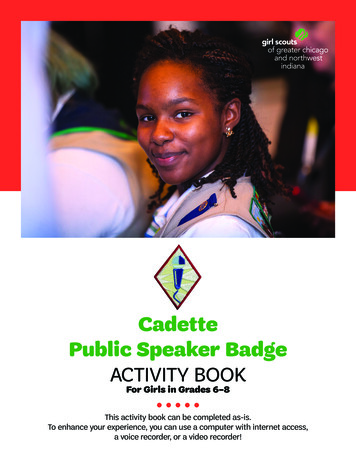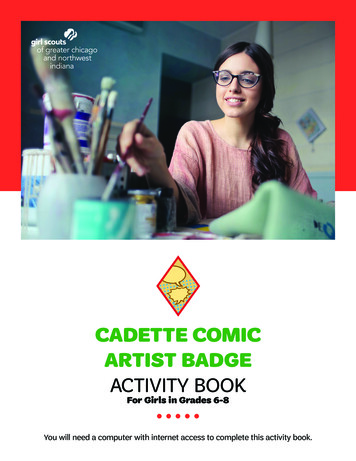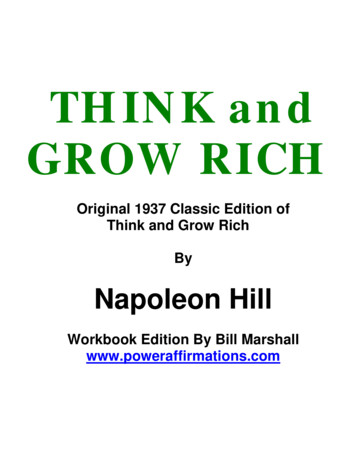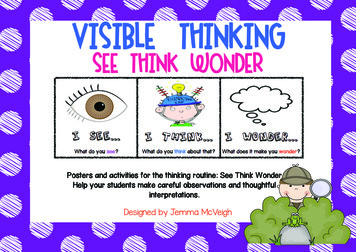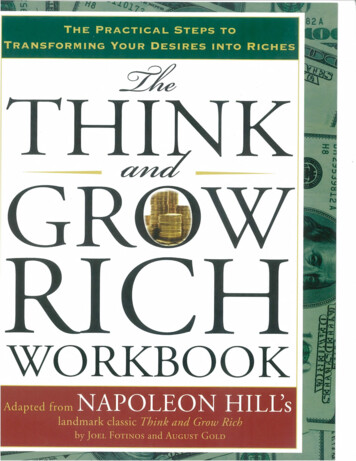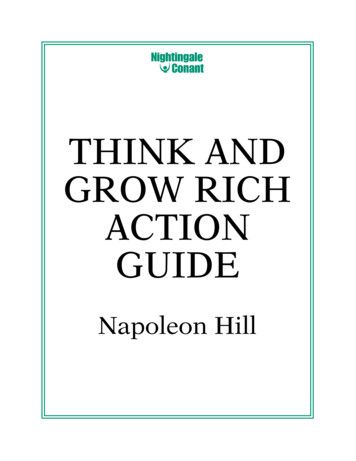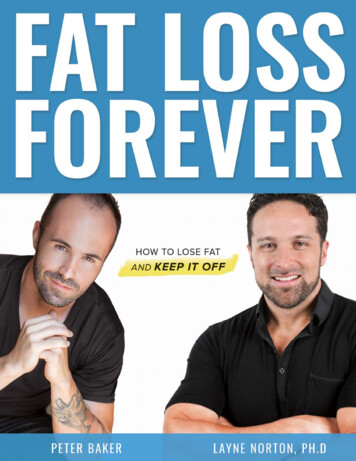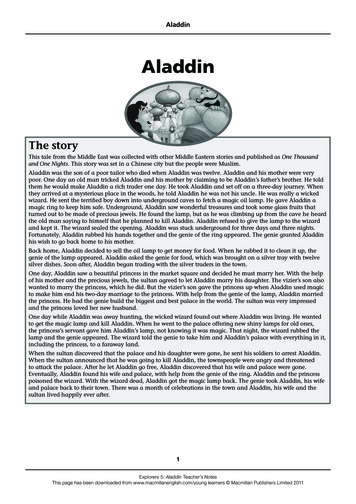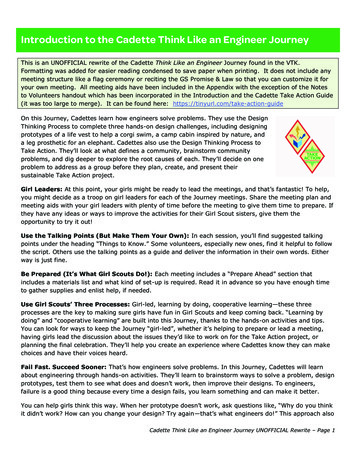
Transcription
Introduction to the Cadette Think Like an Engineer JourneyThis is an UNOFFICIAL rewrite of the Cadette Think Like an Engineer Journey found in the VTK.Formatting was added for easier reading condensed to save paper when printing. It does not include anymeeting structure like a flag ceremony or reciting the GS Promise & Law so that you can customize it foryour own meeting. All meeting aids have been included in the Appendix with the exception of the Notesto Volunteers handout which has been incorporated in the Introduction and the Cadette Take Action Guide(it was too large to merge). It can be found here: https://tinyurl.com/take-action-guideOn this Journey, Cadettes learn how engineers solve problems. They use the DesignThinking Process to complete three hands-on design challenges, including designingprototypes of a life vest to help a corgi swim, a camp cabin inspired by nature, anda leg prosthetic for an elephant. Cadettes also use the Design Thinking Process toTake Action. They’ll look at what defines a community, brainstorm communityproblems, and dig deeper to explore the root causes of each. They’ll decide on oneproblem to address as a group before they plan, create, and present theirsustainable Take Action project.Girl Leaders: At this point, your girls might be ready to lead the meetings, and that’s fantastic! To help,you might decide as a troop on girl leaders for each of the Journey meetings. Share the meeting plan andmeeting aids with your girl leaders with plenty of time before the meeting to give them time to prepare. Ifthey have any ideas or ways to improve the activities for their Girl Scout sisters, give them theopportunity to try it out!Use the Talking Points (But Make Them Your Own): In each session, you’ll find suggested talkingpoints under the heading “Things to Know.” Some volunteers, especially new ones, find it helpful to followthe script. Others use the talking points as a guide and deliver the information in their own words. Eitherway is just fine.Be Prepared (It’s What Girl Scouts Do!): Each meeting includes a “Prepare Ahead” section thatincludes a materials list and what kind of set-up is required. Read it in advance so you have enough timeto gather supplies and enlist help, if needed.Use Girl Scouts’ Three Processes: Girl-led, learning by doing, cooperative learning—these threeprocesses are the key to making sure girls have fun in Girl Scouts and keep coming back. “Learning bydoing” and “cooperative learning” are built into this Journey, thanks to the hands-on activities and tips.You can look for ways to keep the Journey “girl-led”, whether it’s helping to prepare or lead a meeting,having girls lead the discussion about the issues they’d like to work on for the Take Action project, orplanning the final celebration. They’ll help you create an experience where Cadettes know they can makechoices and have their voices heard.Fail Fast. Succeed Sooner: That’s how engineers solve problems. In this Journey, Cadettes will learnabout engineering through hands-on activities. They’ll learn to brainstorm ways to solve a problem, designprototypes, test them to see what does and doesn’t work, then improve their designs. To engineers,failure is a good thing because every time a design fails, you learn something and can make it better.You can help girls think this way. When her prototype doesn’t work, ask questions like, “Why do you thinkit didn’t work? How can you change your design? Try again—that’s what engineers do!” This approach alsoCadette Think Like an Engineer Journey UNOFFICIAL Rewrite – Page 1
keeps the activity girl-led and fun because Cadettes are free to invent things without feeling the pressureto make them perfect.Leave Time for the Closing Ceremony: If Cadettes are having fun doing a Design Challenge, you maybe tempted to skip the Closing Ceremony so they can keep going—but the Closing Ceremony is absolutelykey to their learning. Here’s why:When Cadettes leave a meeting, they’ll remember how much fun it was to build a camp cabin or to makea prosthetic leg for an elephant. However, they may not realize that they just learned how engineers solveproblems or that they’re good at engineering—unless you tell them.That’s why the Closing Ceremony is so important. It’s where you can connect the dots for Cadettes by: Pointing out how they acted as engineers. (For example: They did rapid prototyping. When one oftheir prototypes didn’t work, they saw that “failure” as helpful feedback and tried something else.They worked together to find solutions. They shared their designs and offered suggestions.)Reminding Cadettes that they are already engineers—and that it’s fun to solve problems usingengineering.Letting them know that they have what it takes to continue exploring STEM.These simple messages can boost Cadettes’ confidence and interest in STEM—and end the meeting on anupbeat note!Tell Your Troop Story: As a Girl Scout leader, you’re designing experiences that Cadettes willremember their whole lives. Try to capture those memories with photos or videos. Cadettes loveremembering all they did—and it’s a great way for parents to see how Girl Scouting helps their Cadettes!And please do share your photos and videos with GSUSA by emailing them to STEM@girlscouts.org (withphoto releases if at all possible!).To Prepare for the Meetings: Before each meeting, you’ll find an Overview, notes to help you PrepareAhead, and a Materials List, all specific to that meeting.Go over new words Cadettes can learn. In the Prepare Ahead section for each meeting, you’ll see alist of words Cadettes may or may not know and how to define them. These words appear in contextthroughout the Meeting Plan and Meeting Aids, but if you need a reminder, refer back to this list. You canfind a full list of vocabulary for the Journey in the meeting aid “Cadette Think Like an Engineer Journey—Glossary”.Read through the Meeting Plan and its Meeting Aids. This will help you become familiar with the flowof the meeting. As you prepare, it’s important to understand the activity steps and Things to Know, butfeel free to adapt the activities to fit your troop, meeting time allotment, and available materials.Before starting, read the referenced handouts located in the Appendix: Cadette Think Like an Engineer Journey - Materials List: Each meeting has its own materialslist. However, if you like to do all of your supply shopping at one time, use this handout. It includesthe materials needed for the entire Journey.Cadette Think Like an Engineer Journey - Glossary: This is a list of words introduced in thisJourney with definitions.Design Thinking Process Poster: This poster describes the steps of the process engineers use tosolve problems. This meeting, use it to introduce Cadettes to the Design Thinking Process and haveit available for them to look at as they take on their first Design Challenge. It will continue to beused throughout the Journey.Cadette Think Like an Engineer Journey UNOFFICIAL Rewrite – Page 2
Take Action Guide: Need some sample project ideas to jumpstart your Take Actionbrainstorming? This handout includes Take Action project ideas to use as inspiration, tips onmaking a sustainable project, and information on the difference between Take Action andCommunity Service.Think, Pair, Share: These facilitation tips will help you to make sure that every girl's voice isheard during brainstorming activities.Cadettes earn two awards -Think Like an Engineer award and the Take Action award following thecompletion of the Take Action project and Journey in Think Like an Engineer Part 6.Cadette Think Like an Engineer Journey Part 1Overview: In this meeting, Cadettes discover how engineers use the Design Thinking Process to solveproblems. They take on a hands-on Design Challenge to engineer a model life vest that gives a model dogthe ability to float. Cadettes also find out about the Take ActionTM project.Prepare AheadThese words are used in Think Like an Engineer Pt. 1: Constraints - ways that you or your design are limited. For example, youmight only have a certain amount of time or materials for your prototype.Criteria - things you or your design needs to accomplish. For example, if yourDesign Challenge is "You must create a tower 4 feet tall" or "You must build astructure that can withstand wind for 30 seconds," those are your criteria.Design Thinking Process - the steps engineers use to design technologies to solveproblems. Engineers begin by identifying a problem that needs to be solved and investigating whathas already been done. Next, engineers imagine different solutions and plan their designs. Then,they create and test their designs and make improvements based on the test results. Finally,engineers communicate their findings to others.Engineers - people who use their creativity and knowledge of math and science to designtechnologies that solve problems. They create infrastructure like bridges, build clean watersolutions like wells, design energy solutions like solar and wind power, build rockets that takeaeronauts into space, and so much more.Prototype - a quick way to show your idea to others or to try it out. It can be as simple as adrawing or it can be made with everyday materials, such as cardboard, paper, string, rubberbands, etc.Technology - anything created by people to help solve a problem or meet a need. Engineersdesign and improve technologies when faced with new problems. Technology can be things thatrequire electricity, such as computers and phones, as well as everyday (and non-electric)items, such as pencils, paper, and water bottles.You will need the following Journey Meeting Aids found in the Appendix: Engineering Notes: Corgi Life Vest (Activity Material): This handout guides Cadettes throughthe Design Challenge. It includes details like criteria and constraints as well as space for groups tobrainstorm solutions and plan their design.Cadette Think Like an Engineer Journey UNOFFICIAL Rewrite – Page 3
Dog Model Template (Activity Material): Groups will use this handout to build a model of acorgi or other animal in As Everyone Arrives: Build an Animal Model. It contains a template withshapes that groups can use to draw and cut out foam shapes to attach to their animal'sbody (can).Other Things You Could Do to Prepare Ahead for this Meeting: Create a sample model dog to show as an example in As Everyone Arrives: Build an Animal Model.Cut the foam pieces for As Everyone Arrives: Build an Animal Model ahead of time, putting each setof pieces into a bag or envelope for groups to easily assemble.Find and print/bookmark picture(s) of corgis and life vests to show during the Design Challenge:Corgi Life Vest.Try it out! Challenge yourself to complete the Design Challenge. This will give you a hands-onchance to troubleshoot issues and solutions for the challenge before you do the activity with yourtroop. For example, while testing, you might find out that the cans you have are too heavy for thedog's body or that the plastic bags you have continue to rip so you'll need something sturdier.Activity 1: As Everyone Arrives: Build an Animal ModelMaterialsEach pair or group of 3 will need: Dog Model Template1 sheet of foam (roughly 9 x 12 in.)1 unopened can (12 oz.)ScissorsDuct tapeOptional: Extra foam and markers to design and build animals other than a dog.StepsWelcome everyone, and have them organize into pairs or groups of 3 to build a model of a corgi or otheranimal for today's Design Challenge. Groups use the Dog Model Template to cut a corgi design fromfoam, attaching the foam pieces to the can with duct tape. They will use the models for testing in DesignChallenge: Corgi Life Vest.THINGS TO KNOW: Today, you'll do a hands-on activity to learn how engineers think.The first step is creating a model of a corgi dog from foam, duct tape and a can.You may want to design and build an animal that isn't a dog, and that's great! Feel free torepurpose the foam sheets and create your own unique animal designs.Activity 2: Opening Ceremony: Engineering EverywhereMaterials Design Thinking Process posterCadette Think Like an Engineer Journey UNOFFICIAL Rewrite – Page 4
StepsBegin the Journey by introducing everyone to engineering. Talk briefly about what engineers do, and askthe group how they would describe engineers' work. Share some of these examples, which connectengineering with helping others (a good way to get everyone interested in the topic!) Everyday Solutions: Engineers solve everyday problems by inventing and building things thatcan be used in the real world, like bridges, buildings, planes. They create new and improvedways to make life easier and more efficient for everyone.Agricultural Solutions: Engineers work with farmers to design new machines, like improvedirrigation (watering) systems, that help them to grow and harvest crops faster and moreefficiently.Water Solutions: Engineers work around the world to build wells and other water systems,providing communities with access to clean water.Manufacturing Solutions: Engineers create machines that speed up the production process.Energy Solutions: Engineers create energy and light systems, like solar and wind power, tobring electricity to communities.Solutions in Times of Disaster: Engineers design structures with disaster in mind. Forexample, following Hurricane Sandy in New York City, engineers evaluated their currentsystems and designed stronger infrastructure for cities like New York to better weather againstany future natural disasters.Technological Solutions: Aerospace engineers design spaceships and satellites, givingastronauts and scientists the ability to learn more about our solar system and universe.After, show everyone the Design Thinking Process poster, and tell them about the awards for thisJourney, using the Things to Know.THINGS TO KNOW: On this Journey, you'll learn how to think like an engineer to solveproblems.Engineers go through certain steps to solve problems. Those stepsare called the Design Thinking Process. First, engineers identify aproblem that needs to be solved and investigate what has alreadybeen done. Next, they come up with different ideas for solutions.They pick one or more possible solutions and create their designs. Then, they test their designsand make improvements based on what they learned. Finally, engineers let other people knowwhat they learned.You will earn two awards on this Journey. The first one is called the "Think Like an Engineer"award. You earn that for solving problems like an engineer.The second one is called the "Take Action" award. You earn that for creating a Take Actionproject that solves a problem in your community and uses what you've learned aboutengineering and technology. Your Take Action project will make a sustainable difference in theworld.For this Journey, you'll use the Design Thinking Process to Take Action. You'll work as one teamidentify a problem, investigate why it happens and who it impacts, brainstorm lots of possiblesolutions for the problem, then choose one solution to plan out in more detail and bring it tolife! After you create your Take Action Project, you'll share it with others, just like engineers!Cadette Think Like an Engineer Journey UNOFFICIAL Rewrite – Page 5
Activity 3: Design Challenge: Corgi Life VestMaterials Prepare ahead: Large plastic tub filled with water and placed in an area of the room that canget wet. This will be the testing station.Towels for testing clean-upDesign Thinking Process posterEngineering Notes: Corgi Life Vest, one for each girlStopwatchOptional Prepare Ahead: Find and print, save or bookmark picture(s) of corgis and life vestsEach pair or group of 3 will need: Model dog created in As Everyone Arrives: Build an Animal Model2 sheets of foam (roughly 9 x 12 in. each)2 plastic bags (strong sandwich bags)3 large rubber bandsMeasuring tapeScissorsDuct tapeExtra blank paper (for planning)Pens or pencilsStepsNote to Volunteers: Give 10- and 5-minute warnings to wrap up, leaving time for the Closing Ceremony.Identify the ProblemHandout Engineering Notes: Corgi Life Vest, and explain today's Design Challenge:Today's Design Challenge: Throughout this Journey, you'll be challenged to design things that make the lives of animalsand humans better. Today, you've been hired by a family who has a corgi named Champ.Corgis have a hard time swimming because of their short legs. In preparation for an upcomingtrip, the family would like a life vest made for Champ that would allow him to play with thechildren in the lake.If you made an animal model other than a dog, use your imagination to create a reason whyyour animal might need to be able to float.When everyone arrived, you worked in groups to create models of Champ (or other animals).You'll use your group's model to test the prototype of your life vests.A prototype is a quick way to show an idea to others or to try it out. It can be as simple as adrawing or it can be made with everyday materials like cardboard, paper, string, rubber bands,etc.As a group, identify the problem you're trying to solve.Cadette Think Like an Engineer Journey UNOFFICIAL Rewrite – Page 6
DISCUSS: What's the problem we're trying to solve? (Answer: Engineer a life vest that will allowChamp to swim in the water.)Do you think this is a problem you can help solve?What's our goal for this Design Challenge? (Answer: The life vest must keep the modeldog's head above water.)Investigate the ProblemBefore they begin to design or build anything, engineers start by asking questions to gather informationabout the problem they are trying to solve. This helps them to brainstorm different ways to solve theproblem(s). Form pairs or groups of 3 for the Design Challenge. In the smaller groups, investigate theproblem by discussing what questions the group has, what do they need to know before you start?For example: Are we limited by time or materials? How long does the dog need to float? Is thereanything we already know about life vests that might help us?After, discuss the criteria and constraints for the Design Challenge. Criteria are things you or your design needs to accomplish. These are specific goals for you oryour prototype.Constraints are ways that you or your design are limited. For example, you might only have acertain amount of time or a limited amount of materials for your prototype.Criteria and Constraints for the Design Challenge: Life vests must allow the dog to float with its head above the water for 10 seconds. The lifevest must attach and detach from Champ as quickly as possible.Each group can use up to two plastic bags, two sheets of foam, three rubber bands, onemeasuring tape, and one pair of scissors. The scissors and measuring tape cannot be used as apart of the life vest.Groups have 20 minutes to engineer their design. Groups cannot test the life vest on Champuntil the designated testing time.After, groups will have 20 minutes to test, iterate, and improve their life vests.Note to Volunteers: Some groups may worry that this is a competition they need to "win." Remindeveryone that professional engineers learn a lot from failure. Failure can help them improve the designs offuture technologies. They can also learn from each other's failures and successes.Brainstorm Solutions, Plan and Build a PrototypeWork in the small groups to design and build the life vest prototypes. Each group will need a set ofsupplies and a model dog or animal (created in As Everyone Arrives: Build a Model Corgi). Make sure eachgroup has the space to brainstorm and create their own unique design.Spend about 5 minutes brainstorming the design and features of their life vests. Encourage ideas bothpossible and impossible before deciding on one of their designs to turn into a prototype.Cadette Think Like an Engineer Journey UNOFFICIAL Rewrite – Page 7
Optional: If groups have trouble brainstorming solutions, show the pictures you brought of pet life vestsand corgis. Explain that often engineers think about who will be using the product and look at what'salready been invented. After they have an idea of what's already been created, they think of ways toimprove the design. As groups plan and build, encourage them to think above and beyond a normal lifevest!After groups have planned, set a timer for 15 minutes to build the life vest prototypes. Encourage eachother to try lots of different solutions to see what works and doesn't work. Remember, the goal is topractice thinking like an engineer, NOT to make a perfect life vest!Test, Evaluate, and RedesignGather around the plastic tub of water for groups to take turns presenting their prototypes.Each group can:1.2.3.Explain their prototype.Predict what they think will happen to their prototype during testing.Test the prototype by attaching their life vest to their model dog as quickly as possible andseeing whether or not their life vest can keep the model dog's head afloat for at least 10seconds.DISCUSS: How could you improve your prototype with more time? Why do you think that idea willimprove your prototype?For the remaining activity time and as materials allow, improve the life vest prototypes using results fromtesting (what worked, what didn't). Retest as needed!If you run out of materials, groups can go back to the drawing board and refine their designs. Are thereways they could change their design to focus on the most important features? Challenge groups toengineer a design that still fits within the material constraints for the Design Challenge.Courtesy of the Museum of Science, Boston. Adapted from the Engineering is Elementary, Go Fish: Engineering Prosthetic Tails. 2014, 2016 Museum of Science.Activity 4: Closing Ceremony: Reflect on Our ResultsMaterials Design Thinking Process posterStepsSharing your design decisions is an important part of the Design Thinking Process. Gather together to talkabout the Design Challenge and how everyone used the Design Thinking Process to build a prototype.QUESTIONS ABOUT THE DESIGN CHALLENGE: What problem did you solve today?What were some possible solutions you came up with?What was challenging about engineering the life vest? Possible Answers: Not enoughmaterials, not enough time, etc.Why do you think your design did/did not work?Cadette Think Like an Engineer Journey UNOFFICIAL Rewrite – Page 8
QUESTIONS ABOUT THE DESIGN THINKING PROCESS: What are some action words to describe what you did today? Possible Answers: Brainstorm,build, cut, collaborate, discuss, team up, etc.Do these steps sound like something engineers use? (Answer: Yes, the Design ThinkingProcess!)Which steps of the Design Thinking Process did you use to engineer your life vest?Did you do the steps in a particular order?Did you return to any of the steps more than once?Explain that because everyone in the room just engineered a life vest, everyone used the Design ThinkingProcess to solve a problem!Optional: Talk about any to-do's for the next meeting. This might include assigning a Girl Leader for thenext meeting or deciding on materials to bring in for the next Design Challenge.Cadette Think Like an Engineer Journey Part 2Cadettes learn about bioinspiration as they work together to engineer a model camp cabin inspired bynature. They also talk about what defines a community before brainstorming community problems thatcould lead to a sustainable Take Action project.Prepare AheadThese words are used in Think Like an Engineer Pt. 2. Bioinspiration - the process of being inspired by living things. Bioinspiredengineering is a new and growing field. It combines knowledge ofengineering and natural sciences to develop technologies that are oftenmore sustainable than those not inspired by nature. Many technologies arebioinspired, such as Velcro strips inspired by plant burrs or aerodynamic cars shaped like boxfish. Materials engineering - the field of engineering focused on designing materials with desiredproperties. Materials engineers use their understanding of the properties of different materials(such as metals, plastics, or woods) to design and improve technologies. In particular, materialsengineers explore the properties of different materials to help them choose which material willwork best to solve the problem.You will need the following Journey Meeting Aids found in the Appendix: Engineering Notes: Camp Cabin: This handout guides girls through the Design Challenge. Itincludes details like criteria and constraints as well as space for groups to brainstorm solutions andplan their design.Animal Shelter Examples: This handout provides examples of animal shelters to use asinspiration for the Design Challenge. While the handout includes several different examples,encourage the group to think above and beyond what shelters are there for their design!Cadette Think Like an Engineer Journey UNOFFICIAL Rewrite – Page 9
Other Things You Could Do to Prepare Ahead for This Meeting: Find and print out (or bookmark!) pictures of other animal shelters to show during the DesignChallenge.Try it out! Challenge yourself to complete the Design Challenge. This will give you a hands-onchance to troubleshoot issues and solutions for the challenge before you do the activity with yourtroop.Activity 1: As Everyone Arrives: What's a Community?Materials Prepare Ahead: Before the meeting, create 2 large chart papers. Label them with "Communityis." and "Types of Communities"Tape to hold posters on walls (Alternatively, place papers on different floor/table areas around themeeting space.)MarkersStar stickers (Alternatively, girls can draw stars.)StepsNote to Volunteers: This quick activity is meant to help girls to start thinking about the communitiesthey belong to and the issues that affect each community. This activity will give girls ideas for communityproblems they may want to address with a Take Action project. Girl will continue their Take Actionbrainstorm later in the meeting.Welcome everyone as they arrive. Have them gather around the papers and work as a team to write down1) what community means to them and 2) all of the communities they can think of. Remind everyone tothink about both big and small problems!THINGS TO KNOW: Something engineers do is spot problems in the world and designtechnology and solutions that help others in their community.In today's world, your community might be something small, like yourschool or neighborhood, or something much bigger, like the globalcommunity!Before we get started with the today's activities, let's think about what it means to be a communityor what makes a community.Then, create a list of all the communities you can think of, starring the ones that you think you area part of. No idea is too big or too small!Activity 2: Opening Ceremony: Brainstorm Problems in OurCommunityMaterials Community lists from As Everyone Arrives: What's a Community?Take Action GuideDesign Thinking Process posterCadette Think Like an Engineer Journey UNOFFICIAL Rewrite – Page 10
StepsShare the Design Thinking Process poster, and remind everyone that the Design Thinking Process issimilar to the steps of Take Action. To Take Action, the troop will team up to: Identify a problem in theircommunity, come up with a sustainable solution, develop a plan, put the plan into action, reflect on whatthey've learned, and share the project with others.Discuss the first activity, As Everyone Arrives: What's a Community?, to zero in on a community to impactwith the group's Take Action project. First, look at what the group wrote under "A community is."Reflect on what's there, forming a loose definition of what your group considers a community. Then, lookat the list of communities, reflecting on whether they fit into the group's definition of a community.DISCUSS: Do the communities we listed fit into our definition of a community?Which of these communities are you a part of? Are there any we are all a part of?What other communities (not listed) are you a part of?What role(s) do you play in each of these communities?Have the group choose one of the communities to focus on with their Take Action project. Once the grouphas decided, congratulate everyone on choosing the community to impact, or the user(s), for their TakeAction project! After, begin to brainstorm problems that affect the chosen community ("our community").DISCUSS: What are some issues or problems that impact our community?Who else is in our community? What are some of their problems?Which of the problems could have an engineering or technological solution?Which of these issues are you most interested in? Which do you most care about?For more examples of Take Action projects, use the Take Action Guide. Girls can use the examples asthought starters that will help them develop their own ideas.Silver Award Connection: The group may come up with many Take Action ideas, but they only need tochoose one for this Journey. Remind girls that the list they developed can be a great starting point for aSilver Award project! This Journey's Take Action project helps girls build' skills, like such as criticalthinking, project management and communication, that will help them to develop an excellent SilverAward project. Throughout the discussion, take notes on the group's growing list of community problems.Save these for the next meeting.Activity 3: Design Challenge: Camp Cabin Inspired byNatureMaterials Design Thinking Process posterEngineering Notes: Camp Cabin, one for each girl1 ball of string1 electric fan, approximately 9 inches1 roll of aluminum foil1 spray bottle with waterCadette Think Like an Engineer Journey UNOFFICIAL Rewrite – Page 11
Construction paper, each group will need a quarter sheet of construction paper for testingStopwatchOptional Prepare Ahead: Find and print, save or bookmark pictures of other animal shelters.Each pair or group of 3 will need: 1 piece of mask
Cadette Think Like an Engineer Journey UNOFFICIAL Rewrite – Page 1 Introduction to the Cadette Think Like an Engineer Journey This is an UNOFFICIAL rewrite of the Cadette Think Like an Engineer Journey found in the VTK. Formatting was added


